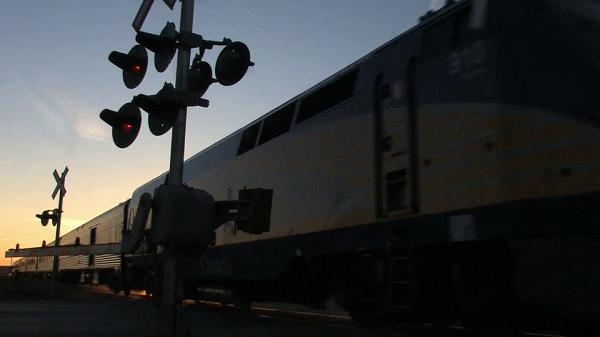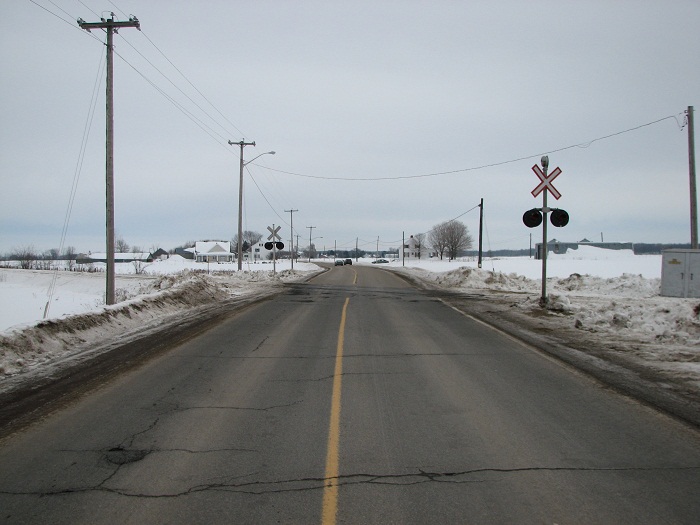Rail transportation safety investigation R13D0001
The TSB has completed this investigation. The report was published on 15 January 2014.
Table of contents
Crossing collision
VIA Rail Canada Inc.
Train number 601
Mile 98.79, Joliette Subdivision
Joliette, Quebec
The occurrence
On 09 January 2013, at about 0950 Eastern Standard Time, VIA Rail Canada Inc. passenger train No. 601, while proceeding at 60 mph northward on the Canadian National Joliette Subdivision, struck a westbound vehicle at the rang de la Deuxième-Chaloupe public crossing at Mile 98.79 near the town of Joliette, Quebec. As a result of the collision, the vehicle’s 2 occupants were fatally injured.
Passenger trains colliding with vehicles
In its Watchlist 2012, the TSB identified passenger trains colliding with vehicles as one of nine safety issues that pose the greatest risk to Canadians. The TSB is calling for action on this issue.

Media materials
News releases
Dense fog led to January 2013 crossing collision between a passenger train and a vehicle near Joliette, Quebec
Read the news release
Deployment notice
Transportation Safety Board of Canada deploys a team to investigate a rail accident near Joliette, Quebec
The Transportation Safety Board of Canada (TSB) is deploying a team of investigators to the site of a rail accident near Joliette, Quebec. At approximately 9:50 this morning, a VIA Rail train struck a vehicle at a crossing. The TSB will gather information and assess the occurrence.
Investigation information
Map showing the location of the occurrence
Investigator-in-charge
Mr. Miller joined the Transportation Safety Board of Canada (TSB) in 2002 and has been a senior investigator with the Rail and Pipeline Investigations Branch since 2004. During that time he has participated in over 40 investigations while also performing the duties of standards and performance specialist.
Before joining the TSB, Mr. Miller worked for consulting companies in the resource sector providing geological expertise. In this capacity, he was responsible for the development, management and successful completion of exploration projects.
Mr. Miller's education credentials include a Bachelor of Science degree in Geological Sciences from Queen's University in Kingston, Ontario, and a Masters of Business Administration degree from the University of Toronto, Ontario.
Photos
Download high-resolution photos from the TSB Flickr page.
Class of investigation
This is a class 3 investigation. These investigations analyze a small number of safety issues, and may result in recommendations. Class 3 investigations are generally completed within 450 days. For more information, see the Policy on Occurrence Classification.
TSB investigation process
There are 3 phases to a TSB investigation
- Field phase: a team of investigators examines the occurrence site and wreckage, interviews witnesses and collects pertinent information.
- Examination and analysis phase: the TSB reviews pertinent records, tests components of the wreckage in the lab, determines the sequence of events and identifies safety deficiencies. When safety deficiencies are suspected or confirmed, the TSB advises the appropriate authority without waiting until publication of the final report.
- Report phase: a confidential draft report is approved by the Board and sent to persons and corporations who are directly concerned by the report. They then have the opportunity to dispute or correct information they believe to be incorrect. The Board considers all representations before approving the final report, which is subsequently released to the public.
For more information, see our Investigation process page.
The TSB is an independent agency that investigates air, marine, pipeline, and rail transportation occurrences. Its sole aim is the advancement of transportation safety. It is not the function of the Board to assign fault or determine civil or criminal liability.


